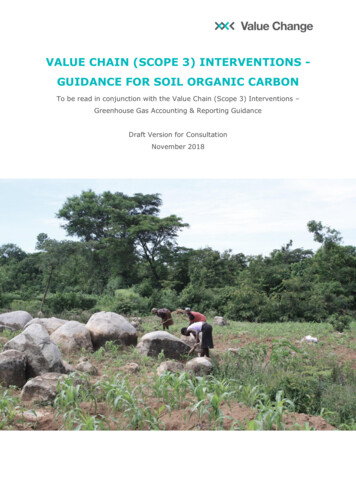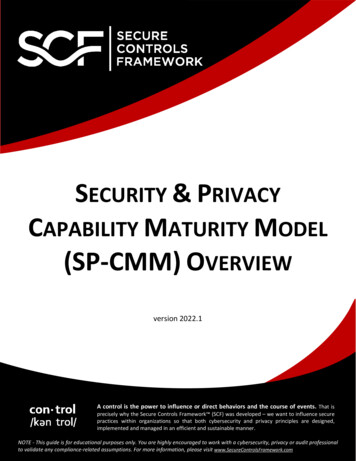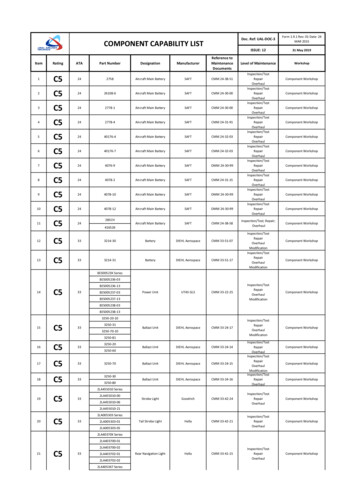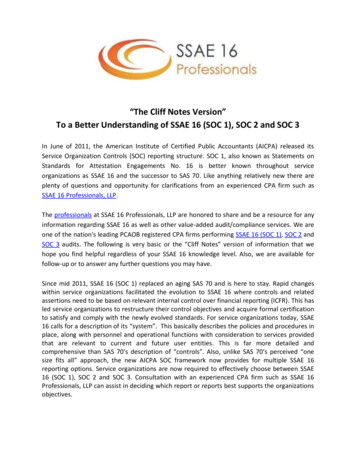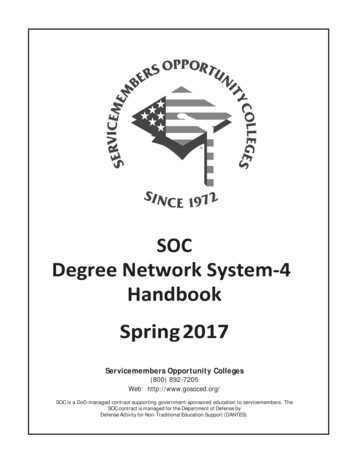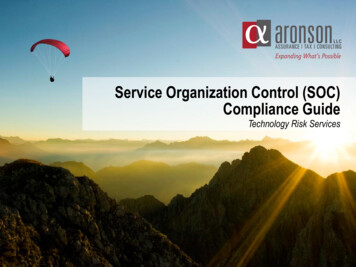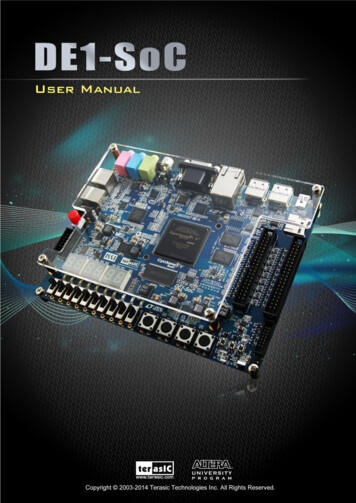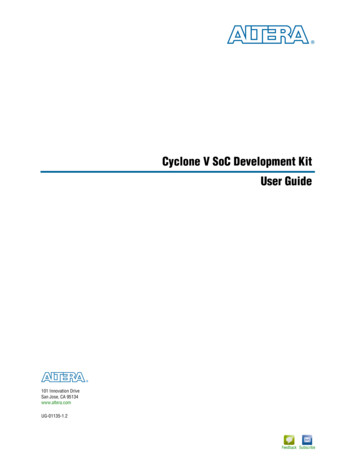
Transcription
SOC-CMM: Designing and Evaluating aTool for Measurement of CapabilityMaturity in Security Operations CentersRob Van OsInformation Security, masters level2016Luleå University of TechnologyDepartment of Computer Science, Electrical and Space Engineering
SOC-CMM: Designing and Evaluating a Tool forMeasurement of Capability Maturity in SecurityOperations Centers*Photo of VISA SOC by Melissa GoldenMaster Thesis, Information Security ProgramNameStudent IDDateRob van Osrobvan-230.09.2016
ContentsLIST OF ABBREVIATIONS . 3ABSTRACT . 41INTRODUCTION. 51.11.21.31.42METHODOLOGY . 82.12.22.33LITERATURE RESEARCH – PART 1 . 13IDENTIFY PROBLEM. 13EXPERT INTERVIEWS . 13PRE-EVALUATE RELEVANCE . 13PHASE II: SOLUTION DESIGN . 154.14.24.34.45DESIGN SCIENCE RESEARCH . 8PROPOSED SOLUTION . 12LITERATURE REVIEW . 12PHASE I: PROBLEM IDENTIFICATION . 133.13.23.33.44BACKGROUND . 5RESEARCH GAP . 6PROBLEM STATEMENT . 6THESIS OUTLINE. 7LITERATURE RESEARCH – PART 2 . 15SURVEY . 23DESIGN ARTEFACT . 31THE DESIGN ARTEFACT: SOC-CMM. 42PHASE III: EVALUATION. 435.15.25.35.4REFINED HYPOTHESES . 43EXPERT SURVEY . 43CASE STUDY / ACTION RESEARCH. 44LABORATORY EXPERIMENT. 446PHASE IV: SUMMARISE RESULTS . 477CONCLUSION . 487.17.27.37.48DISCUSSION . 548.18.28.38.49REQUIREMENTS EVALUATION . 48REFINED HYPOTHESES EVALUATION . 50CENTRAL HYPOTHESIS EVALUATION . 52FINAL CONCLUSION . 53RESEARCH METHODOLOGY . 54RESEARCH PARTICIPANTS . 56RESEARCH RESULTS . 57FURTHER RESEARCH . 59A FINAL WORD . 61ANNEX A: LITERATURE STUDY OUTCOME. 62ANNEX B: SURVEY INTRODUCTION PAGE . 64ANNEX C: LABORATORY EXPERIMENT EVALUATION FORM . 65ANNEX D: LIST OF FIGURES AND TABLES . 68ANNEX E: REFERENCES . 69SOC-CMM: Designing and Evaluating a Tool for Measurement of Capability Maturity in Security Operations Centers Copyright 2016, Rob van OsPage 2 of 74
List of COBITCSBNCSIRTCSOCDRDSDMDSRFAA-iCMMFTEHPEHPE T ion for Computing MachineryAction Design ResearchAnalytic Hierarchy ProcessAction ResearchCybersecurity Capability Maturity ModelChief Executive OfficerComputer Emergency Response TeamCapability Maturity ModelCMM IntegrationCMMI for ServicesControl Objectives for Information and related TechnologyCyber Security Assessment Netherlands (Cyber Security Beeld Nederland)Computer Security Incident Response TeamCyber Security Operations CenterDesign ResearchDynamic System Development MethodologyDesign Science ResearchFederal Aviation Administration integrated CMMFull Time EquivalentHewlett Packard EnterpriseHPE Security Operations Maturity ModelIndustrial Control System Supervisory Control And Data AcquisitionIntrusion Detection and Prevention SystemsInstitute of Electrical and Electronics EngineersInformation Sharing and Analysis CenterInformation Security Management SystemInformation TechnologyInformation Technology Infrastructure LibraryLiterature ReviewMust have, Should have, Could have, Won’t haveNational Institute of Standards and TechnologyNational Institute of Standards and Technology Cyber Security FrameworkNational Security AgencyOpen Information Security Management Maturity ModelSecurity Information and Event ManagementSystematic Literature ReviewSecurity Operations CenterSecurity Operations Center Capability Maturity ModelSystems Security Engineering CMMSecurity Quality Requirements EngineeringSOC-CMM: Designing and Evaluating a Tool for Measurement of Capability Maturity in Security Operations Centers Copyright 2016, Rob van OsPage 3 of 74
AbstractThis thesis addresses the research gap that exists in the area of capability maturity measurement forSecurity Operations Centers (SOCs). This gap is due to the fact that there is very little formal researchdone in this area. To address this gap in a scientific manner, a multitude of research methods is used.Primarily, a design research approach is adopted that combines guiding principles for the design ofmaturity models with basic design science theory and a step by step approach for executing a designscience research project. This design research approach is extended with interviewing techniques, asurvey and multiple rounds of evaluation.The result of any design process is an artefact. In this case, the artefact is a self-assessment tool thatcan be used to establish the capability maturity level of the SOC. This tool was named the SOC-CMM(Security Operations Center Capability Maturity Model). In this tool, maturity is measured across 5domains: business, people, process, technology and services. Capability is measured across 2domains: technology and services. The tool provides visual output of results using web diagrams andbar charts. Additionally, an alignment with the National Institute of Standards and Technology CyberSecurity Framework (NIST CSF) was also implemented by mapping services and technologies to NISTCSF phases.The tool was tested in several rounds of evaluation. The first round of evaluation was aimed atdetermining whether or not the setup of the tool would be viable to resolve the research problem.The second round of evaluation was a so-called laboratory experiment performed with severalparticipants in the research. The goal of this second round was to determine whether or not thecreated artefact sufficiently addressed the research question. In this experiment it was determinedthat the artefact was indeed appropriate and mostly accurate, but that some optimisations wererequired. These optimisations were implemented and subsequently tested in a third evaluationround. The artefact was then finalised.Lastly, the SOC-CMM self-assessment tool was compared to the initial requirements and researchguidelines set in this research. It was found that the SOC-CMM tool meets the quality requirementsset in this research and also meets the requirements regarding design research. Thus, it can be statedthat a solution was created that accurately addresses the research gap identified in this thesis.The SOC-CMM tool is available from http://www.soc-cmm.com/SOC-CMM: Designing and Evaluating a Tool for Measurement of Capability Maturity in Security Operations Centers Copyright 2016, Rob van OsPage 4 of 74
1 IntroductionCyber criminals are continuously searching for new ways to infiltrate businesses through theirInformation Technology (IT) systems or simply disturbing the business by exhausting their ITresources. More recent examples include the theft of large sums of money from several institutionsthrough Chief Executive Officer (CEO) fraud (also known by the name of ‘Business EmailCompromise’) [1, 2], the hacking of the national Security Agency (NSA) [3], cyber attacks on banks[4], attacks on the Ukrainian power grid [5, 6] and the theft of information on 500 million Yahooaccounts [7].The professionalism of the ‘adversaries’ requires a professional approach from companies defendingagainst such threats as well. Part of the defence strategy is the aggregation of several dedicatedoperational security functions into a single security department. This way, an overview is createdthat allows the department to gain insight into the current state of security for the organisation. Inturn, this allows this department to identify threats, weaknesses and current attacks and provides ameans for appropriate response. This security department is known as the Security OperationsCenter (SOC). Note that the United States English spelling is used here, as this is the spelling that iscommonly used in the industry.This thesis examines a specific topic for governance in SOCs: capability maturity measurement.Capability maturity measurements are used in many areas, both within and outside the IT domain,for determining how processes or elements in an organisation are performing. This outcome canthen be used to determine weaknesses and strengths of those elements and thereby determineareas that require improvement. By regularly assessing maturity and capabilities, and using theoutput to provide direction to the governance process, it becomes possible to achieve the goals setby the SOC in a demonstrable way.1.1BackgroundAs indicated, a SOC is and organisational entity in which operational security elements, such assecurity incident response, security monitoring, security analysis, security reporting and vulnerabilitymanagement, are centralised. These operational processes and tasks are often aggregated into theSOC as the organisation grows in size. This way, security-related operational processes are carriedout be the same personnel and under the same accountable organisational entity. This hasadvantages in organisational and operational sense, but also makes sense from a knowledgemanagement perspective as security expertise can be aggregated and optimised. Additionally, theSOC allows for a more coordinated effort in incident detection and response that reduces securityrisks [8].Determining how the SOC performs within the enterprise is important in understanding the securityrisks that the organisation is faced with. A well performing SOC is able to detect and react to securitythreats, thus reducing the impact of potential security incidents. To determine the performance ofthe SOC, regular measurements are required. These measurements should focus on determining theweak and strong elements in the SOC. Such measurements help to create a roadmap to more matureand capable security operations. The information can be used to provide focus where required andkeep on track with information security maturity goals. Additionally, the information can be used toSOC-CMM: Designing and Evaluating a Tool for Measurement of Capability Maturity in Security Operations Centers Copyright 2016, Rob van OsPage 5 of 74
proof to senior management that the SOC is performing as expected, or potentially that it requiresadditional funding or other (such as human) resources [9].1.2Research gapMaturity measurements are a widely used tool for evaluating strengths and weaknesses. Becausedifferent kinds of security-related activities are aggregated into the SOC, determining the maturitylevel of the SOC as a whole requires determining the maturity level of each of those elements.Currently, there are no well-established capability maturity level assessments available SOCs. This ismainly because there is no standard of which common elements are present in a SOC. In otherwords, there is no such thing as a ‘standard SOC’ or ‘Standard SOC model’. A generic capabilitymaturity model, such as Capability Maturity Model Integration (CMMI) could be applied, but yieldsgeneric results as the context is not specific for the element under investigation. Creating a specificcontext requires an interpretation of the generic maturity model for that specific element.Some research has been done in the field of SOC models, but these do not provide sufficient detail ora specific focus on capability maturity. For example, Jacobs et al. [10] have researched a SOCclassification model, which is based on maturity, capability and aspects. Aspects, in this paper areSOC functionalities or services. In their paper, Jacobs et al. explicitly state that insufficient literatureis available on this particular subject. Kowtha et al. [11] have research a Cyber SOC (CSOC)characterisation model which is based on 5 dimensions: scope, activities, organisational dynamics,facilities, process management and external interactions. Although maturity is mentioned in theirwork, this is not the focus of the research. Therefore, there is not sufficient information regardingmaturity in their work. Their research is based on interviews with many SOC managers to determinesimilarities between SOCs. A more detailed outcome of their research can be found in their paper“An Analytical Model For Characterizing Operations Centers” [12]. Lastly, Schinagl et al. [13] haveresearched a framework for SOCs by performing a case study with several SOCs. This was requiredbecause, as they state: “each SOC is as unique as the organization it belongs to”. They describe somecommon SOC functions and elements that a grouped into 4 areas: intelligence, secure servicedevelopment, business damage control and continuous monitoring. The paper also presents a modelin which the SOC can be scored on using a rating level for each element identified. However, thisscoring is not elaborated in detail and is not an indication of maturity, but rather of satisfaction,which is more prone to interpretation. As a last note, it must be stated that the previously mentionedresearch efforts are mostly based on case study research and some best-practices and whitepapersreleased by commercial companies. These are important indicators that research in this area iscurrently insufficient.Note that this research focuses on capability maturity to evaluate the SOC. Other characteristics,such as operational performance (efficiency and effectiveness), are not within scope of this research.1.3Problem statementIn order to address the previously stated research gap regarding the availability of SOC capabilitymaturity models, research is required. The proposed research as outlined in this document aims toaddress the following research question:"How can the performance and improvement of a Security Operations Center be measured?"SOC-CMM: Designing and Evaluating a Tool for Measurement of Capability Maturity in Security Operations Centers Copyright 2016, Rob van OsPage 6 of 74
The next chapter outlines the methodology for addressing this research question. The researchquestion is answered in chapter 7.1.4Thesis outlineThis thesis consists of 9 chapters:1. Introduction. The current chapter, which describes the background and problem statementfor this research.2. Methodology. In this chapter, the methodology for the research into SOC capability maturitymeasurement is explained. Additionally, the artefact that is the result of the research asdescribed in thesis is identified.3. Phase I: Problem identification. This chapter describes the first phase of the research, inwhich the main problem is identified and made concrete.4. Phase II: Solution design. This chapter describes the second phase of the research, in whichthe solution is created.5. Phase III: Evaluation. This chapter describes the third phase of the research, in which thesolution is evaluated and improved.6. Phase IV: Summarise Result. This chapter describes the final phase of the research, in whichthe results are summarised.7. Conclusion. In this chapter, the results from the previous phases are evaluated andconclusions about the research are presented.8. Discussion. In this final chapter, the research is discussed. Possibilities for further researchare identified as well.9. Final wordAdditionally, there are 6 annexes added to this thesis.SOC-CMM: Designing and Evaluating a Tool for Measurement of Capability Maturity in Security Operations Centers Copyright 2016, Rob van OsPage 7 of 74
2 MethodologyThe methodology used in this research is a proactive research methodology: The Design ScienceResearch (DSR) or simply Design Research (DR). This type of research is appropriate for researchareas that are not clearly defined as is the case for SOCs: there is no formal definition of whatelements are part of the SOC and no complete model of when these characteristics can beconsidered ‘mature’. Because of the lack of research in this field, the creation of a solution to theproblem described in the previous chapter must be carried out in a more proactive manner. DRprovides a scientific research approach for this pragmatic and more creative process aimed atinnovation and building a bridge between theory and practice [14, 15, 16]. This is also the main goalof this research: to create a solution that can be immediately applied by companies everywhere todetermine the capability maturity of their SOC, outline the steps for improvement and measure theprogress. The result should thus be first and foremost a practical one.2.1Design Science ResearchThe methodology used in this thesis is based on 3 perspectives on design research:1. The work by Walls et al. [14], who outlined several basic concepts for design research: metarequirements, meta-design, kernel theories and testable design product hypotheses.2. The work by Becker et al. [17], who have outlined 8 requirements for the design of maturitymodels. These requirements are based on the 7 guidelines for design research by Hevner etal. [18]. Hevner et al. describe a conceptual framework that combines behavioural science(through development and justification of theories) and design science (through building andevaluation). This means that the end result is both useable and based upon formal research,thus matching the research goal stated in the previous paragraph.3. The work by Offermann et al. [19], who outline a step by step methodology for doing designresearch.These 3 perspectives are described below.2.1.1 Basic concepts of DSRAccording to Walls et al., design science should have a strong theoretic foundation. Maturity modelsgenerally lack such a theoretic foundation [20]. The foundation for design research, according towalls et al. lies in 4 aspects:1. Meta-requirements. These are the foundation requirements that guide the design process. Inthis case, the design product should be: effective in determining the maturity level andstrengths and weaknesses, accurate in determining the right maturity level and easy to use inorder to support the possibility of self-assessment.2. Meta-design. This is the class of artefacts that need to be created in order to fulfil the designgoals set in the meta-requirements. In this case, the main class of the artefacts is “maturitymodels”. Additionally, given the fact that self-assessment is required, the maturity model isalso an instantiation of a “self-assessment tool”.3. Kernel theories. Kernel theories are a central part of the theoretic foundation in designresearch. This is emphasised in other research [21, 22] as well, although different views exist[23]. In this particular case, the kernel theory revolves around 2 basic concepts:- A maturity (self-)assessment can be used to determine the next steps for progression andimprovement [24, 17]. This is also confirmed by the practical application and widespreadadoption of maturity models throughout organisations [25].SOC-CMM: Designing and Evaluating a Tool for Measurement of Capability Maturity in Security Operations Centers Copyright 2016, Rob van OsPage 8 of 74
-Decision making around a complex subject like maturity can be done by breaking it downinto criteria and sub-criteria and evaluating those. The theoretic basis for this is inanalytic hierarchy process (AHP) [26, 27] and relative decision making [28]. This is similarto the work done by Van Looy et al. [29].4. Testable design product hypotheses. The last central element in the design researchperspective by Walls et al. is testable design product hypotheses. These are used todetermine whether the meta-design (artefacts) is appropriate to fulfil the goals set in themeta-requirements. These hypotheses overlap with the research steps as outlined byOffermann et al. and are discussed in paragraphs 3.4 and 5.1.2.1.2 Step-by-step methodology of DSRThe step-by-step methodology as presented in the work by Offermann et al. is applied to thisresearch. Chapters 3 through 6 are outlined in accordance with the phases and steps as described intheir research. The methodology consists of 11 steps, executed in 3 research phases. These phasesare:- Problem identification- Solution Design- EvaluationThe research phases and steps are depicted in Figure 1 (source: Offermann et al., “Outline of aDesign Science Research Process” [19]).Figure 1: Design Science Research steps, according to Offermann et al.SOC-CMM: Designing and Evaluating a Tool for Measurement of Capability Maturity in Security Operations Centers Copyright 2016, Rob van OsPage 9 of 74
The figure shows the 3 main phases of the research and the way in which each of the steps areinterconnected. The arrows represent advancement possibility through the research steps. Thedotted lines represent the possibility of having to re-design the artefact or even restate the problembased on results of the case study / action research. Each of the phases will be briefly discussedbelow.Phase I: Problem identificationThe first phase of the methodology aims at clearly defining the problem statement and making thegoals of the research concrete. This phase includes an initial literature review (LR), combined withexpert interviews and relevance determination in order to create a relevant and well-foundedproblem statement.Phase II: Solution designThe second phase of the methodology focuses on the creation of a design artefact. A second roundof literature review is required to create an artefact that has sufficient scientific foundation. In thisresearch, the solution design phase was carried out using a literature review on 3 different topics:1. SOCs as a whole2. Elements of SOCs3. Capability Maturity Models (CMMs) and their applicability to the elements uncovered intopic 1 and further specified in topic 2An additional step was introduced into the research methodology to determine the correctness ofthe information found in literature review. This additional step consists of performing a survey. Thereason for adding this step to the research methodology is the lack of formal research on SOCs. Thereare many publications on SOCs, but most of these are whitepapers and best-practices. Since theseare not scientific publications, there is insufficient formal input for a well-founded scientific artefact.Thus, the additional step of performing a survey to test the requirements was introduced. Therefore,the solution design phase for this research looks somewhat different from the standardmethodology, as depicted in Figure 2.Figure 2: Modified Solution Design phaseSOC-CMM: Designing and Evaluating a Tool for Measurement of Capability Maturity in Security Operations Centers Copyright 2016, Rob van OsPage 10 of 74
The figure shows that an additional verification step (survey of SOCs) is added between the LR onSOCs and the creation of the design artefact. In the survey, all elements and their details found in theliterature review are tested for application in actual SOCs. This allows for differentiation betweentheoretical SOC elements and practical (actual) SOC elements. The LR on CMMs was used directly asinput into the ‘Design Artefact’ step as this literature had sufficient scientific foundation. The outputfrom the survey, together with the LR is used to create the design artefact (tool).Phase III: EvaluationIn the evaluation phase, the Design Artefact is evaluated and refined. For evaluation, differentapproaches can be applied. Hevner et al. describe 5 different evaluation methods that can be used inthis phase (see Figure 3). From these methods, the case study (observational method) and controlledexperiment (experimental method) are aligned with the evaluation phase as described by Offermannet al. The case study method allows for an in depth application of the artefact to a businessenvironment. The controlled experiment method allows for the use of the artefact (tool) by severalorganisations for testing purposes in a controlled experiment. The goal is to uncover any potentialdefects, validate the functional appropriateness and accuracy of the tool and improve the tool fromthe feedback obtained from the participants of the test. By testing in multiple iterations, the tool iscreated and tested in a controlled fashion.Figure 3: Design Evaluation Methods from Hevner et al.In figure 3, the 5 different high-level testing methodologies and the 12 different detailedmethodologies for evaluation of the artefact are shown. This research uses case study and controlledexperiment methods.SOC-CMM: Designing and Evaluating a Tool for Measurement of Capability Maturity in Security Operations Centers Copyright 2016, Rob van OsPage 11 of 74
Phase IV: Summarise resultsThe final phase of the research is to summarise and publish the results. A summary of the results isprovided in the conclusion chapter. The publication is this thesis.2.1.3 Design of maturity modelsIn their research, Becker et al. indicate that the work by Hevner is an excellent basis for designresearch in general. However, they also conclude that these are generic practices that can beadapted specifically to the design of maturity models for a more focussed approach. These claims arebased on the work done by Zelewski [30]. These adaptations are repre
The tool provides visual output of results using web diagrams and bar charts. Additionally, an alignment with the National Institute of Standards and Technology Cyber Security Framework (NIST CSF) was also implemented by mapping services and technologies to NIST CSF phases. The tool was tested in several rounds of evaluation.

